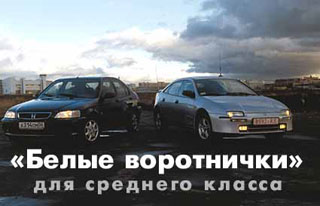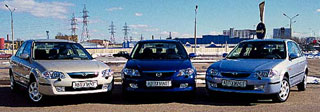Test drive Mazda 323 F 1994 - 1997 hatchback
On every day
 Japanese cars penetrated our market almost simultaneously with European ones. The first were, of course, Toyota, Nissan and Mitsubishi. But Mazda cars began to appear in Russia a little later, first, used cars from Germany (model 626, for example, according to the results of sales, repeatedly became a car of the year among foreign cars), which showed themselves well in our conditions, and then new ones. Nevertheless, the official sales of Mazda models began only in the spring of this year.
Japanese cars penetrated our market almost simultaneously with European ones. The first were, of course, Toyota, Nissan and Mitsubishi. But Mazda cars began to appear in Russia a little later, first, used cars from Germany (model 626, for example, according to the results of sales, repeatedly became a car of the year among foreign cars), which showed themselves well in our conditions, and then new ones. Nevertheless, the official sales of Mazda models began only in the spring of this year. Mazda 323 belongs to the most popular golf class. By this spring, the 1998 model has undergone some technical and cosmetic changes, in other words, restyling is also Feyslifting. For the test we got a car with a sedan body, a mechanical gearbox and a 1.6-liter 98-horsepower engine, which replaced a 1.5-liter 88-horsepower unit. And instead of a 1.8 liter engine, the 323rd is now equipped with a 2-liter 131-strong one, which was previously available only for the 626th model. Horse force gained and a 2-liter turbodiesel now has 101 of them, 11 more. And they abandoned the atmospheric diesel.
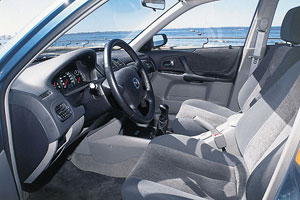 Only the smallest 72-horsepower engine with a volume of 1.3 liters remained unchanged.
Only the smallest 72-horsepower engine with a volume of 1.3 liters remained unchanged. Outwardly, Mazda 323 is a very nice and proportional car. The face has become more predatory and expressive thanks to the accented ribs-substetricians on the hood, smoothly turning into the framing of the false radiator lattice, and the embossed bumper with an integrated spoiler is very similar to a larger 626th model. In general, the new 323rd looks richly crystal headlights, foglights, chrome cross-member and a large proprietary emblem. At the back of the Mazda with lanterns and the trunk integrated into the trunk lid, it resembles the Audi A4 of the previous generation here, everything is unchanged, except for the bumper, which (like the front) is now without molding. In general, the design is clean, without unnecessary decor.
Castles are unlocking from the keyboard. The cabin is light and spacious. The materials used by light shades are pleasant to the touch and look quite expensive. The interior without any delights, but is made very high -quality both in materials and the adjustment of the panels, which gives it solidity, creating a sensation of a higher class. It is strengthened by the inserts imitated under the black tree on the central console and in the doors, chrome door handles, as well as the steering wheel and lever of the CP.
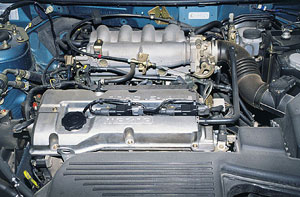 All controls at hand. The dashboard is not overloaded with excess information and is well read. Not particularly embossed in the appearance of the seat showed themselves in the case thanks to the materials of upholstery with increased friction. The driver's seat has four mechanical adjustments along the length, the corner of the back, the corner and the height of the pillow, which allows you to quickly select the optimal landing. There are enough places both in height and in width. For example, the back of the front passenger seats also took care of comfort, forming a convenient table with two profiled cup holders (however, this has long been a branded feature of the Mazda models), a convenient subcuttor box (as on the 626th), two cup holders, two cup holders, two, two, two A roomy glove compartment, regular music. The ventilation system is controlled by three rotating switches. Our 323rd was equipped with four airbags in front (at the driver and the front passenger) and one in each front seat.
All controls at hand. The dashboard is not overloaded with excess information and is well read. Not particularly embossed in the appearance of the seat showed themselves in the case thanks to the materials of upholstery with increased friction. The driver's seat has four mechanical adjustments along the length, the corner of the back, the corner and the height of the pillow, which allows you to quickly select the optimal landing. There are enough places both in height and in width. For example, the back of the front passenger seats also took care of comfort, forming a convenient table with two profiled cup holders (however, this has long been a branded feature of the Mazda models), a convenient subcuttor box (as on the 626th), two cup holders, two cup holders, two, two, two A roomy glove compartment, regular music. The ventilation system is controlled by three rotating switches. Our 323rd was equipped with four airbags in front (at the driver and the front passenger) and one in each front seat. The back is no less spacious. With a fully shifted front seat, there are plenty of place for the legs. Thanks to the almost horizontal (contrary to fashion) the ceiling will not even put the ceiling even on the tall passenger. That's just the third row is not waiting for the third row, although the headrest in the middle hints at the opposite. But if necessary, you can tolerate.
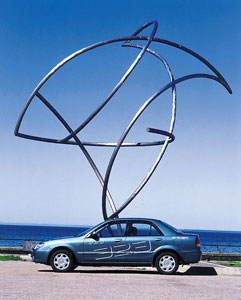 The trunk is not particularly large 415 liters, but the reserve there is placed full -size. There are no problems with visibility, the dimensions are felt well, in a dense city stream and when maneuvering you feel confident.
The trunk is not particularly large 415 liters, but the reserve there is placed full -size. There are no problems with visibility, the dimensions are felt well, in a dense city stream and when maneuvering you feel confident. The engine is practically not heard on the idle. With the touch of problems, the clutch and gas were not very informative. Switching is light and unambiguous. Mazda 323 does not require any adaptation as if he had traveled all his life on this car. The motor is quite elastic and pulls well from the bottom, easily spinning until the limiter is triggered. And if you stay above 3500-4000 about/min., Then you can make a laugh.
The 323rd confidently follows a straight path even at speeds close to maximum. When passing turns, it is easily controlled by the steering wheel and gas, everything again is simple and clear. With large angles of rotation, a certain lack of reactive effect on the steering wheel is manifested, but this is a modest fee for good maneuverability and light steering wheel, which can be freely rotated with one hand.
The brakes are quite effective, but they lack information content a little, in addition, the free pedal’s free course appeared high. ABS works in combination with the brake force distribution system (EBD) and an electronic stabilization system (TCS) with such equipment not every classmate can boast.
 The suspension, of course, is not the top of comfort, but you can’t call it stool. Small irregularities and joints are transmitted to the body with stupid, elastic shocks. Mazda obediently repeats the profile of the road, but does not annoy the buildup. In general, an acceptable combination of comfort and controllability.
The suspension, of course, is not the top of comfort, but you can’t call it stool. Small irregularities and joints are transmitted to the body with stupid, elastic shocks. Mazda obediently repeats the profile of the road, but does not annoy the buildup. In general, an acceptable combination of comfort and controllability. The 1.6-liter motor is noisy in some modes, it blocks the rest of the noises (aerodynamic and from the road), repulsing the desire to give gas. But this is the trouble of most low -power engines. Mostly the microclimate is satisfactory.
A very decent machine. Expressive and at the same time not screaming appearance, spacious and convenient salon, simple and understandable control that does not require addiction. Yes, and on the roads, Mazda models did not have time to become familiar. What else to demand from the car for every day?
Sergey Yakubov
A source: Motor magazine [August 2001]

